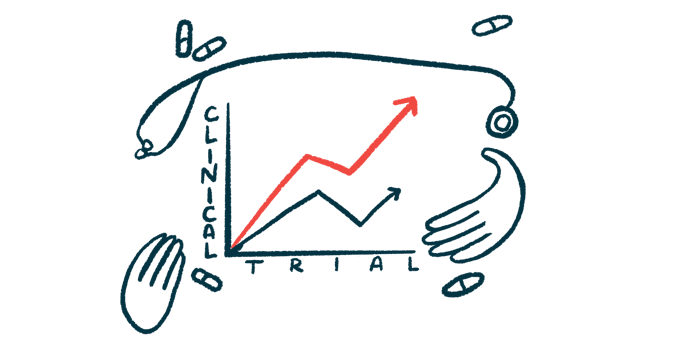Add-on danicopan seen to benefit PNH patients on Soliris, Ultomiris
Oral therapy already under regulatory review in US, EU based on trial data

Add-on danicopan treatment led to better control of anemia among paroxysmal nocturnal hemoglobinuria (PNH) patients experiencing residual red blood cell destruction, or hemolysis, while on Soliris (eculizumab) or Ultomiris (ravulizumab), according to data from a Phase 3 clinical trial.
The addition of the investigational oral therapy to a standard regimen of Soliris or Ultomiris also reduced patients’ dependence on blood transfusions relative to a placebo, as well as helping to ease fatigue and improve aspects of life quality.
“These Phase 3 results show that danicopan has a positive benefit-risk profile as oral add-on therapy to [Ultomiris] or [Soliris],” the researchers wrote.
Danicopan is currently under regulatory review in the U.S. and Europe as an add-on therapy for PNH based on these and other trial data.
The new study, “Addition of danicopan to ravulizumab or eculizumab in patients with paroxysmal nocturnal hemoglobinuria and clinically significant extravascular haemolysis (ALPHA): a double-blind, randomized, phase 3 trial,” was published in The Lancet Haematology. It was funded by Alexion, AstraZeneca Rare Disease, the name by which Alexion Pharmaceuticals — which developed Soliris and Ultomiris and is developing danicopan for PNH — became known after being acquired by AstraZeneca.
New data shared from interim analysis of Phase 3 trial of danicopan
In PNH, uncontrolled activation of the immune system’s complement cascade leads to hemolysis, which ultimately results in anemia. This condition is characterized by a lack of hemoglobin, the protein in red blood cells needed to carry oxygen throughout the body.
Both of the approved antibody-based PNH therapies Soliris and Ultomiris are designed to prevent abnormal activation of the complement cascade, and work by suppressing a complement protein called C5.
While these help prevent intravascular hemolysis, or the destruction of red blood cells inside blood vessels, about 10% to 20% of patients on either therapy will experience persistent anemia. This is thought to be due to clinically significant extravascular hemolysis — where red blood cells are destroyed outside blood vessels, mostly in the liver and spleen.
Extravascular hemolysis in these patients is believed to be associated with the continuous binding of C3 — a protein positioned earlier than C5 in the complement cascade — to surviving, but damaged, red blood cells, marking them for destruction.
As such, researchers believe that adding a medication that suppresses the complement cascade at an earlier point could be of benefit to patients. Such a medication would help prevent extravascular hemolysis in patients on C5 inhibitors while still enabling adequate control of intravascular hemolysis.
Danicopan, formerly known as ALXN2040, is designed to be that medication, and block factor D, an enzyme involved in C3 production.
Data from early PNH trials demonstrated danicopan’s possible efficacy in patients who had never used a C5 inhibitor, and as an add-on treatment in individuals with an inadequate response to Soliris.
The ongoing global Phase 3 ALPHA trial (NCT04469465), launched in 2020, is evaluating the safety and efficacy of danicopan as an add-on therapy to a standard regimen of Soliris or Ultomiris. It involves 86 adults with PNH and clinically significant extravascular hemolysis.
Participants were randomly assigned to receive oral danicopan — at a dose of 150 mg that could be increased to 200 mg — or a placebo three times daily for 12 weeks, or about three months. The therapy was given on top of a standard Soliris or Ultomiris regimen.
After 12 weeks, all participants receive danicopan as an add-on treatment for an additional 12 weeks. Then, patients could enter a long-term extension phase in which they continue the therapy for up to two years.
The newly published results concern a pre-specified interim analysis planned for when about three-quarters of participants had been randomly assigned to treatment and completed or discontinued at 12 weeks.
Patients see increase in hemoglobin levels without need for blood transfusion
As of a data cut-off point of June 2022, 63 participants had completed the 12-week treatment period and were included in the efficacy analysis. Among them, 42 were given danicopan while 21 received the placebo.
An additional 10 patients — seven on danicopan and three on the placebo — were still receiving treatment at the data cutoff and were included in the safety analysis.
The results showed that add-on danicopan led to statistically significant and clinically meaningful increases in hemoglobin levels compared with the placebo at 12 weeks (by 2.94 vs. 0.5 g/dL) — meeting the trial’s main goal.
Significant group differences were observed as early as week 1, and were deemed clinically meaningful by week two.
Compared with those on the placebo, a significantly higher proportion of danicopan-treated patients experienced a clinically meaningful hemoglobin rise without the need for blood transfusions (60% vs. 0%), were transfusion-free (83% vs. 38%), and achieved normalized hemoglobin levels after 12 weeks (12% vs. 0%).
Blood measurements indicated that danicopan led to a significant decrease in C3 deposits and significant reductions in markers of extravascular hemolysis, with opposite trends observed in the placebo group. Also, “adequate control of intravascular hemolysis … was maintained in both groups for 12 weeks,” the researchers wrote.
Patients on the experimental therapy also experienced statistically significant and clinically meaningful reductions in fatigue and significant gains in some aspects of life quality relative to the placebo group.
These findings indicated that all of the study’s secondary goals, and some exploratory goals, also favored the experimental therapy.
The findings from this clinical trial provide evidence that danicopan is effective as an add-on therapy to [Soliris or Ultomiris] in patients with PNH experiencing clinically significant extravascular hemolysis, with a favorable benefit-risk profile, potentially improving quality of life for these patients.
Moreover, “safety data appear consistent with the safety profiles of previous clinical studies” of each of the three therapies, the researchers noted.
The most common side effect seen at a higher frequency in the danicopan group was headache. Liver-related side effects were observed in 12% of danicopan-treated patients and 8% of those on the placebo. Most of these side effects were temporary and without symptoms.
No serious side effects were deemed related to danicopan and no deaths occurred during the study.
“The findings from this clinical trial provide evidence that danicopan is effective as an add-on therapy to [Soliris or Ultomiris] in patients with PNH experiencing clinically significant extravascular hemolysis, with a favorable benefit-risk profile, potentially improving quality of life for these patients,” the researchers wrote.









